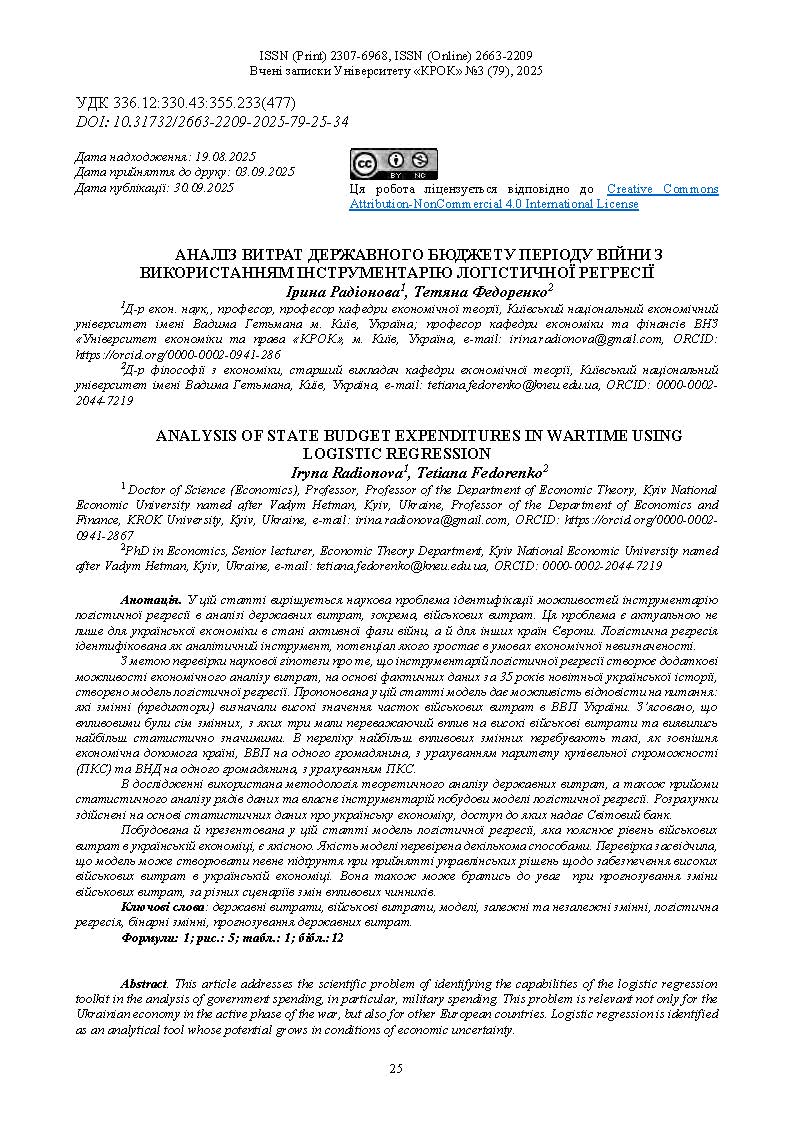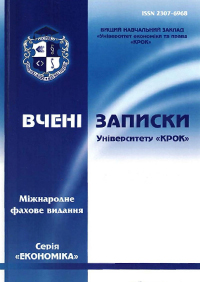ANALYSIS OF STATE BUDGET EXPENDITURES IN WARTIME USING LOGISTIC REGRESSION
DOI:
https://doi.org/10.31732/2663-2209-2025-79-25-34Keywords:
government spending, military spending, models, dependent and independent variables, logistic regression, binary variables, forecasting government spendingAbstract
This article addresses the scientific problem of identifying the capabilities of the logistic regression toolkit in the analysis of government spending, in particular, military spending. This problem is relevant not only for the Ukrainian economy in the active phase of the war, but also for other European countries. Logistic regression is identified as an analytical tool whose potential grows in conditions of economic uncertainty.
In order to test the scientific hypothesis that the logistic regression toolkit creates additional opportunities for economic analysis of spending, a logistic regression model was created based on actual data for 35 years of modern Ukrainian history. The created model makes it possible to answer the question: which variables (predictors) determined the high values of the shares of military spending in Ukraine's GDP. It was found that seven variables were influential, of which three had a predominant impact on high military spending and turned out to be the most statistically significant. The list of the most influential variables includes such as foreign economic assistance to the country, GDP per capita, taking into account purchasing power parity (PPP), and GNI per capita, taking into account PPP.
The study used the methodology of theoretical analysis of government spending, as well as methods of statistical analysis of data series, and the actual tools for building a logistic regression model. The calculations were made on the basis of statistical data on the Ukrainian economy, access to which is provided by the World Bank.
The logistic regression model constructed and presented in this article, which explains the level of military spending in the Ukrainian economy, is qualitative. The quality of the model was checked in several ways. The check showed that the model can create a certain basis for making management decisions on ensuring high military spending in the Ukrainian economy. It can also be taken into account when forecasting changes in military spending, under different scenarios of changes in influential factors.
Downloads
References
Abbasov, R. (2025) Government Budgeting and Expenditure: A Multifaceted Analysis of Economic Growth, Fiscal Sustainability, and Social Impact. iBusiness, 17, 32-55. doi: 10.4236/ib.2025.171002.
Affes, Z., & Hentati-Kaffel, R. (2019). Predicting US banks bankruptcy: Logit versus canonical discriminant analysis. Computational Economics, Springer;Society for Computational Economics, 54(1), 255–271. DOI: 10.1007/s10614-017-9698-0
Coman, A. C., Lupu, D., & Nuţă, F. M. (2023). The impact of public education spending on economic growth in Central and Eastern Europe. An ARDL approach with structural break. Economic Research-Ekonomska Istraživanja, 36(1), 1261–1278. https://doi.org/10.1080/1331677X.2022.2086147
Florio, M., & Colautti, S. (2005). A logistic growth theory of public expenditures: A study of five countries over 100 years. Public Choice, 122 (3–4), 355–393. https://doi.org/10.1007/s11127-005-3900-y
HM Treasury. (2024). Public expenditure statistical analyses 2024. UK Government. https://assets.publishing.service.gov.uk/media/66a8dd93ab418ab055592fb9/E03149684_PESA_2024_Web_Accessible.pdf
Jabeur, S. B. (2017). Bankruptcy prediction using partial least squares logistic regression. Journal of Retailing and Consumer Services, 36, 197-202. https://doi.org/10.1016/j.jretconser.2017.02.005.
Li, Z. (2017). Political trust and public satisfaction: A logistic regression analysis based on 1113 samples. Open Journal of Business and Management, 5, 208-214. doi: 10.4236/ojbm.2017.51019
Nguyen, M.-L. T., & Bui, N. T. (2022). Government expenditure and economic growth: Does the role of corruption control matter? Heliyon, 10(8), e13653. https://doi.org/10.1016/j.heliyon.2022.e10822
Pandey, P., & Pandey, M. M. (2015). Research methodology: Tools and techniques. Bridge Center. https://www.euacademic.org/BookUpload/9.pdf
Piatti-Fünfkirchen, M., Brumby, J., & Hashim, A. (2020). Government analytics using expenditure data. World Bank. https://openknowledge.worldbank.org/server/api/core/bitstreams/98869b85-74e6-4a2e-988d-3aba32e26aaa/content
Trading Economics. (n.d.). Ukraine GDP per capita PPP. https://tradingeconomics.com/ukraine/gdp-per-capita-ppp
World Bank. (n.d.). World development indicators. DataBank. https://databank.worldbank.org/source/world-development-indicators

Downloads
Published
How to Cite
Issue
Section
License

This work is licensed under a Creative Commons Attribution-NonCommercial 4.0 International License.

